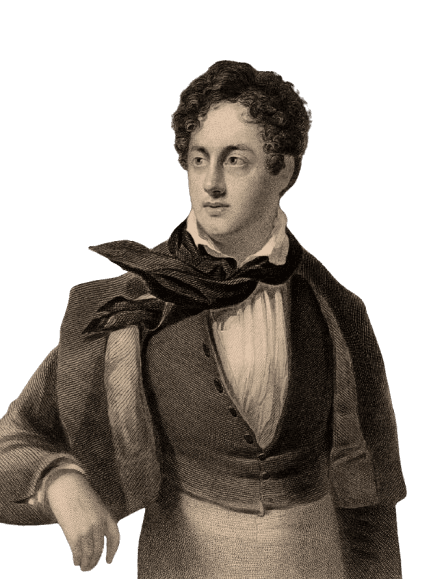Life and achievements
Early life
George Gordon Byron, the sixth Lord Byron, was born on January 22 1788, in London, England. His father, Captain John "Mad Jack" Byron, spent most of the family wealth and thus left Byron and his mother, Catherine Gordon, in a poor state. They shifted to Aberdeen in Scotland, where they led a simple life with a low income. Byron was a clubfoot, a deformity that must have made his childhood very painful and humiliating; however, his education at Harrow School and later at Trinity College, Cambridge, showed his potential as a poet.
Byron was born to an aristocratic family and was titled Baron Byron. When he was ten years old, he inherited the family estate, Newstead Abbey. This inheritance gave him status and thus brought him certain duties and obligations, which defined his early aspirations and identity. Harrow and Cambridge's years were filled with learning and friendship, some of which would remain lifelong, such as with John Cam Hobhouse, whom he would later travel with.
Byron's first poems and his first collection of poems, entitled 'Hours of Idleness, ' published in 1807 were not well received, and this led him to write a satirical poem ', English Bards and Scotch Reviewers'. This work set the tone for Byron's poetry as a wit and a rebel. Financial problems and physical disabilities were the issues that Byron had to struggle with, but his determination and love for literature helped him to overcome all the barriers.
His first love, his cousin Mary Chaworth, who did not reciprocate his feelings, became the subject of his poetry reflecting love and the sense of life. The author's relationship with his mother was also rather tense, although they were close; this also played a significant role in forming his personality and creativity. These early years set the stage for his future success and the development of the Byronic hero – a literary type of hero who is dark, rebellious, and in search of identity in a dark and broken world.
Legacy
Lord Byron is undoubtedly one of the most famous poets of the Romantic era in English literature. He remains an exciting personality, and his works have inspired scholars, readers, and artists. Byron's poetry, marked by its passion, depth of emotions and biting satire, became a model for future poets.
Thus, the Byronic hero, created by Byron, became one of the most famous literary and cultural archetypes. This particular archetype, which combines charisma, rebellion, and inner conflict, has been used in many novels, movies, and other works of art. The author's life was full of scandal, adventures, and the constant desire for freedom, which made him a legendary figure, and his heroes could not be like him.
Byron greatly supported the Greek War of Independence and thus earned the title of a liberator. His services to the Greek struggle in terms of money and presence made him a national hero in Greece. Tombstones and memorials in Greece commemorate him; his work is observed yearly on Byron Day.
Byron's personal life was questionable and has remained a subject of discussion; however, his literary contributions remain impressive. His most famous poems are Childe Harold's Pilgrimage, Don Juan, and Manfred, all of which are still considered significant works due to their language, exploration of human passions, and criticism of society. This paper shows that Byron was able to use satire while conveying profound philosophical messages in his poetry.
The revival of the Byron Society in 1971, as well as the functions of other Byron Societies in different parts of the world, are evidence of his popularity. Annual conferences, publications, and scholarly research are still being conducted to analyze and describe his life and work. The Royal Mail celebrated Byron in 2020 with a stamp to mark the 250th anniversary of the birth of the Romantic movement and other British poets.
Byron's impact is not only literary but also musical, theatrical, and visual. His poetry was put to music by composers like Beethoven and Schubert, and his rather dramatic life has been the subject of operas and plays. Thus, Byron's place in the history of poetry and literature and his image as a romantic hero will always be relevant and remembered by future generations.
Milestone moments
Jan 22, 1788
George Gordon Byron is born
George Gordon Byron was born in London on January 22, 1788, to Captain John "Mad Jack" Byron and Catherine Gordon. His father was a rather wastrel, and many of the family's resources were frittered away, leaving Byron and his mother in somewhat straitened circumstances. Byron was a clubfoot, but his early education laid down his literary abilities.
Mar 16, 1812
Release of the work "Childe Harold's Pilgrimage"
The first two cantos of "Childe Harold's Pilgrimage" were published in March 1812, and Byron became an overnight success. The semi-autobiographical poem based on his journeying was well received by readers and helped establish him as one of the major poets of the Romantic period.
Apr 16, 1816
Exile from England
Byron was forced into exile and left England in April 1816 under the cloud of scandal and financial woes, but he never returned. He moved to Geneva with the Shelleys and remained productive, creating such works as "Manfred." His voluntary banishment was a fruitful time and a time of introspection.
Jul 16, 1823
Support for Greek Independence
Byron left Italy in July of 1823 to join the fight in the Greek War of Independence against the Ottoman Empire. He gave his money to the Greek side and led a division of soldiers. He was a great fighter for freedom; for this, he is considered a national hero in Greece.
